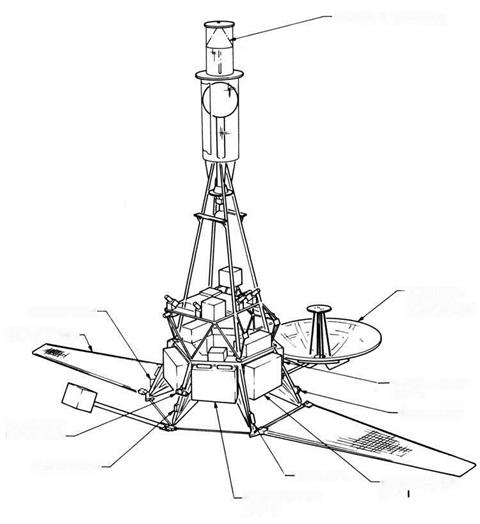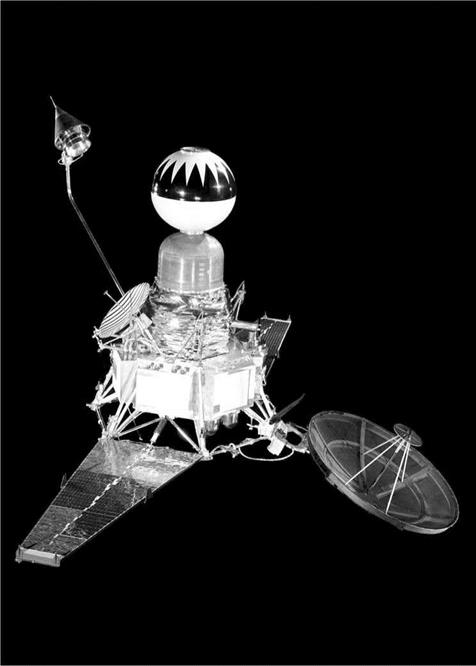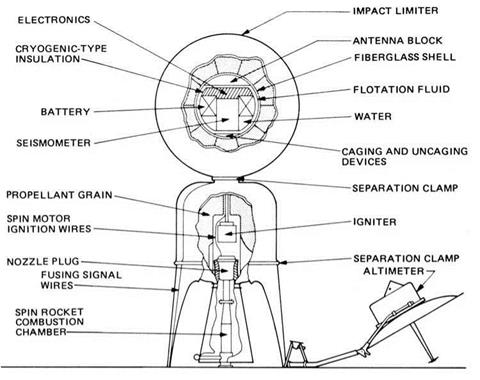THE SPACECRAFT
In March 1958 Major General John B. Medaris of the Army Ballistic Missile Agency requested JPL to compute the payload that could be dispatched into deep space by a configuration of the Jupiter launch vehicle that would later be named the Juno IV.
The result prompted W. H. Pickering to ask Daniel Schneiderman, head of a payload design group that included James Burke, to study preliminary concepts for a spacecraft capable of a flyby of Mars. They outlined a З-axis stabilised vehicle that would face flat arrays of transducer cells to the Sun for power and maintain a high – gain antenna pointing at Earth. It was decided the craft would require a small rocket engine to correct a modest trajectory error inherited from the launcher. These points were accepted by a review in June. When the Juno IV was cancelled in October, JPL proposed that the Atlas-Vega be developed with the capability to dispatch 265 kg to the Moon or 200 kg to either Venus or Mars. To reduce the development costs and improve reliability, JPL decided that all deep-space missions should use a common ‘bus’ to provide not only the main structure but also electrical power, command and control functions, communications, З-axis attitude control and midcourse correction. Peripheral structures would be held against the bus for launch, and be deployed in space.
When in July 1959 NASA told JPL to focus on the Moon in the short-term, the laboratory decided to stick with the bus concept so as to exploit this development to prepare for planetary missions in 1962. This made Ranger much more sophisticated than strictly required for a flight to impact on the Moon. Although recognised to be a high-risk venture in the short term, this strategy was expected to pay off in the long term. The preliminary outline was submitted to NASA on 1 August. The scientific payload for Ranger was to be specified by the Office of Space Flight Programs, and Silverstein delegated this task to Homer Newell. By the autumn, Newell’s working groups and JPL had agreed on a rough priority for experiments to be carried on six Vega-launched lunar flights. The first two spacecraft, designated Block I, would not be sent towards the Moon, but would test the basic spacecraft systems in the deep – space environment by using Earth orbits with apogees significantly beyond the orbit of the Moon. The spacecraft engineers had argued for not carrying any experiments, in order to increase the mass available to provide redundancy in key systems until their reliability could be determined, but Newell insisted that such orbits provided an excellent opportunity to study particles and fields in space. The Block II spacecraft would be devoted exclusively to studying the Moon. However, then the Vega was cancelled and Silverstein directed JPL to prepare a five-flight series for the Atlas – Agena B. On 28 December 1959 Pickering proposed that the bus it had planned for the Vega-launched spacecraft be revised to suit the Agena B, and NASA concurred. Once again, the first two missions would be test flights carrying particles and fields payloads.
Daniel Schneiderman issued the design concept for Ranger on 1 February 1960. Reflecting the fact that the frame of the third stage of the Atlas-Vega was to have been hexagonal, the bus was a hexagonal disk 1.5 metres in diameter. The systems would be contained in rectangular boxes on its sides. For the test flights, a ‘tower’ was to be mounted on top of the hexagon with a platform to support the experiments and a fixed low-gain antenna on the tip. It would not, however, have the midcourse engine. On the underside would be a wider hexagonal frame scaled to mate with the Agena, and this would have a pair of solar panels that would be held against the bus for launch and hinged out in space, and a 1.2-metre-diameter high-gain antenna dish
![]()
 ELECTRONICS
ELECTRONICS
BAY VI
Details of the Block I Ranger spacecraft.
that would be stowed directly beneath the bus for launch and gimballed out in space. The Systems Division at JPL completed the design of the Block I in May I960, and Burke froze it. The design was then split up in terms of functions and the individual tasks assigned to the various divisions. These missions were to provide data on flight performance in space that could not be gained by testing on the ground – at least not with the facilities then in existence.
The Block II spacecraft would have the same hexagonal frame, solar panels and high-gain antenna, but include the midcourse engine and a structure to accommodate a rough landing package. The operational flights were to activate a TV camera and a gamma-ray spectrometer during the terminal approach and,
 OMNI ANTENNA
OMNI ANTENNA
MAGNETOMETER
ION CHAMBER
LYMAN ALPHA TELESCOPE
COSMIC DUST DETECTOR
ELECTROSTATIC ANALYZER
PITCH & ROLL JETS
VELA HOTEL EXPERIMENT
EARTH SENSOR
ANTENNA GEAR BOX
YAW JETS
ELECTROSTATIC
ANALYZER
FRICTION EXPERIMENT
SUN SENSOR
SOLAR PANEL
HIGH-GAIN ANTENNA
ELECTOSTATIC ANALYZER
The configuration of the Block I Ranger spacecraft.
shortly prior to impact, eject the landing package that contained a single-axis seismometer. Conceived at a time when America’s only experience in deep space was the Pioneer probes, this was an extremely ambitious design.
JPL contracted out the development of the surface package. It was an experiment, and as such represented a distraction to the spacecraft engineers since it would not directly contribute to the exploitation of the bus for planetary missions. In February I960 JPL issued three competitive contracts. It received the proposals on 15 April, and on 25 April selected the one submitted by the Aeronutronic Division of the Ford Motor Company. The design mounted the spherical capsule above a solid-propellant
retro-rocket (later revised to a liquid engine) and at an appropriate height above the Moon a pulse-type radar altimeter dish antenna would command separation from the bus. At burnout, the retro-rocket would be jettisoned. A crushable shell of balsa would protect the fibreglass capsule from the impact, and the scientific payload would be immersed in high-viscosity fluid. Once the capsule had come to rest, the offset centre of mass of the payload would allow it to adopt an upright orientation within the fluid. Including its support structure, the surface package subsystem had a mass budget of 136 kg. The propulsion was contracted to the Hercules Powder Company, and the altimeter to the Ryan Aeronautical Company. The contract for the battery powered single-axis seismometer had been placed in July 1959 with Frank Press at the Seismological Laboratory at Caltech and Maurice Ewing at the Lamont-Doherty Geological Observatory at Columbia University. It was a magnet suspended in a coil by a spring, and restrained radially so that it would respond only to motion parallel to its axis. It weighed 3.6 kg, and by floating it in a viscous fluid inside the ‘survival shell’ of the 44-kg capsule it could withstand the deceleration force of 3,000 times Earth gravity on hitting the ground at 60 m/s. Aeronutronic’s contract called for the first surface subsystem to be delivered by September 1961. The company formed a Lunar Systems group headed by Frank G. Denison specifically for the project, and he was to report to Burke at JPL.
|
Details of the surface package subsystem of the Block II Ranger spacecraft. |
The Ranger spacecraft would require 100 to 150 watts of power when fully active, which was to be generated by a pair of solar panels. Attitude determination would be by photocells and gyroscopes. Attitude control would be by thrusters squirting cold nitrogen gas. After being released by the Agena, the spacecraft would deploy its solar panels and orient itself to face its longitudinal axis towards the Sun for power generation, then aim its high-gain antenna at Earth. Later, it would have to adopt the attitude required for the midcourse manoeuvre, then re-establish its cruise attitude. This burn would be made by a hydrazine monopropellant rocket engine. Because the engine was installed beneath the hexagonal framework, it could not be fired until the high-gain antenna had swung clear. The autopilot would hold the vehicle’s attitude during the manoeuvre using vanes in the rocket exhaust. For the Block I, a simple ‘alarm clock’ would prompt a sequencer to perform the various actions of deploying the solar panels, locking onto the Sun and deploying the high – gain antenna. For the more demanding Block II, a ‘computer’ would drive the sequencer – but the attitude for the midcourse manoeuvre and the magnitude of the burn would be specified by Earth. The low-gain antenna was for use after the craft was released by the Agena and before it adopted cruise attitude, and later for the midcourse manoeuvre during which the high-gain antenna would not attempt to hold its ‘lock’ on Earth. The high-gain antenna would send telemetry while cruising, and scientific data (including TV) during the terminal approach. On the Block II, a boom would swing the low-gain antenna away from its initial position above the surface package shortly prior to the terminal approach – by which time the high-gain antenna would have locked on – in order to clear the way for the separation of the surface package, which would occur when the radar altimeter indicated that the slant range had reduced to 24 km.
The Vega-launched Ranger had been allocated a launch mass of 364 kg in order to match the predicted performance of the three-stage Atlas-Vega. NASA’s decision to switch to the Agena B for deep-space missions was based on the expectation that the performance of the Atlas-Agena B would almost match this. But whereas the Air Force’s Agena payloads operated in Earth orbit, NASA wanted the Agena to remain in ‘parking orbit’ only briefly before reigniting its engine to head for deep space. On 11 July I960 Lockheed announced a cut in its estimate of the Agena B’s capability in this role by 34 kg to 330 kg. This did not affect the 307-kg Block I, but the design of the Block II had started out as 364 kg – including the 136-kg surface package subsystem. The issue of the Block II mass remained in doubt through the remainder of the year, with the Agena B Coordinating Board failing to achieve a resolution. Meanwhile, James Burke told Harris Schurmeier’s Space Division to do all it could to lighten the Block II, short of deleting equipment. But by the end of 1960 the mass of the Block II design still exceeded 330 kg. Worse, Aeronutronic warned that their subsystem may well exceed its mass limit. On 14 December the Space Technology Laboratories were asked to re-evaluate the capacity of the Agena B by combining Lockheed’s data for launch to translunar injection and JPL’s data for the remainder of the mission. The calculation would take several months to perform.
In early 1961, awaiting this report, Burke faced a dilemma. To match the overall project timescale of 36 months specified by Silverstein, the schedule called for the test
![]()

|
flights in July and October 1961, and the lunar flights in January, April and July 1962. To achieve this, he would have to commit the Block II to a mass heavier than the currently projected capability of the Atlas-Agena B. Alternatively, he could let the schedule slip until he had a definitive mass figure. Part of NASA’s rationale for Ranger was to steal a march on the Soviets. However, on 12 February 1961 they dispatched a 454-kg spacecraft on an interplanetary trajectory towards Venus. It was З-axis stabilised, had solar panels and a high-gain antenna, and utilised the parking orbit technique rather than direct ascent – all of which JPL had hoped Ranger would pioneer.[14] Under pressure, on 16 February Burke told Schurmeier that the Systems Division “must begin removing items’’ from the Block II in order to lighten it. He also told Aeronutronic that if their subsystem exceeded its allotted mass it would not be carried.[15] The deletions that Burke specified would cut the mass of the Block II to ЗЗ2 kg, which was still marginally greater than Lockheed’s revised estimate. The design of the Block II was frozen in April 1961 at this mass. Ironically, in late May 1961 the Space Technology Laboratories reported that the Agena B would be able to place З82 kg on the Block II trajectory, which was even more than the Vega figure! Rather than introduce a further delay by trying to exploit this situation, Burke let the development proceed. If the actual capability of the Atlas-Agena B in this role had been known when JPL drew up the specifications for the Block II in early 1960, a significant degree of redundancy would have been built into the spacecraft. In fact, the mass-saving exercise had deleted those redundant systems that existed, making it even more technologically risky than initially envisaged. In effect, the design of the Block II was predicated on the assumption that all of its systems would work, which in turn put it at risk of loss if a single system were to fail.
In January 1958 Joshua Lederberg, a geneticist at the University of Wisconsin, warned the National Academy of Sciences that if a spacecraft transported terrestrial microbes to another body of the solar system, this would preclude a later experiment to determine whether life independently originated there. The International Council of Scientific Unions established an ad hoc committee to consider the issue, and then urged all nations to sterilise their spacecraft. On 15 October 1959, with the approval of Keith Glennan, Abe Silverstein directed that any NASA “payloads which might impact a celestial body must be sterilised before launching’’.
The case for such a precaution on planetary missions was self-evident, because at that time the seasonal variation of the dark areas on Mars was widely believed to be due to vegetation, and although the atmosphere of Venus was permanently cloudy, one idea was that conditions on the surface might resemble the carboniferous period of Earth’s past. As regards the Moon, one theory (not widely held, but impossible to falsify with the data available) posited there might be water ice at a shallow depth beneath the surface, and this environment might be conducive to microbial life that would not be able to survive on the surface. It was therefore decided that spacecraft destined for the Moon must be sterilised.
JPL soon decided that NASA’s recommendation of immersing the spacecraft in lethal gaseous ethylene oxide would have to be augmented by ‘dry heat’ treatment. In April I960 George L. Hobby, a research biologist in the Space Sciences Division, was assigned to work with James Burke to draw up sterilisation procedures for the Block II spacecraft. The first task was to define the term ‘sterile’ – which basically was an issue of deciding how efficient the process had to be. Ideally all components and subassemblies would be subjected to a temperature of 125°C for a period of 24 hours, but this proved impractical owing to its deleterious effects on the electronics, and one by one waivers were issued to protect particularly sensitive items. Once the spacecraft had been fully assembled (using the sterilised subassemblies) it would be thoroughly cleaned with alcohol. It would be transported to the Cape in a controlled environment. After the spacecraft had been installed on its launcher and passed its final checks, the aerodynamic shroud would be sealed and gaseous ethylene oxide pumped in for a time to complete the sterilisation process. On 26 June 1961 Robert Seamans approved these procedures.
As a matter of policy, the choice of experiments for space missions was made by Homer Newell’s Space Sciences Steering Committee. Abe Silverstein retained the final approval. Experimenters therefore submitted proposals to NASA headquarters, and, if successful, worked with a field centre to implement the experiment. In the case of JPL, this was the Space Sciences Division. While James Burke concentrated on the spacecraft, the launch vehicle and its support systems, Albert Hibbs prepared the scientific experiments to be carried. The particles and fields experiments did not require much development because they were by now being flown widely, but a lot of care was required to integrate them into the spacecraft. The final list of scientific experiments for the Block I was a solar plasma detector, a magnetometer, a trapped – radiation detector, an ion chamber, a cosmic-ray telescope, a Lyman-alpha detector, a micrometeoroid detector and the Vela Hotel package. The Vela Hotel provided by the Atomic Energy Commission was a late addition which Silverstein approved on 29 June 1960. A network of satellites were to carry X-ray and gamma-ray sensors to detect above-ground nuclear tests. But if the Sun issued microsecond-duration bursts of X-rays, then these might cause the satellites to report false detections. The highly elliptical orbits of the Ranger test flights would have their apogees above the van Allen belts, and the 3-axis-stabilised spacecraft would enable the Vela Hotel sensor to ‘stare’ at the Sun to determine whether it produced such emissions.
The in-flight experiments for Block II consisted of a TV camera and a gamma-ray spectrometer. The TV camera was to be activated by command from Earth when the spacecraft was within 4,000 km of the Moon. The Astro-Electronic Division of the Radio Corporation of America in Hightstown, New Jersey, which had supplied the TV system for the Tiros meteorological satellites, was hired to provide a slow-scan vidicon imaging tube and related electronics. The Space Sciences Division at JPL built the optical element, which was essentially a telescope with a focal length of 1
metre and an aperture ratio of f/6. The image scanned off the vidicon tube would have 200 ‘lines’. The plan was for the camera to provide about 100 pictures during the terminal approach, with the transmission terminating when the separation of the surface package perturbed the attitude of the bus and the high-gain antenna lost its lock. In excellent ‘seeing’, the best telescopes had a lunar surface resolution of about 300 metres. An image taken by this camera at an altitude of 50 km was expected to provide a resolution 100 times better. On 16 October 1961 Newell’s Space Sciences Steering Committee named Gerard Kuiper, Gene Shoemaker and Harold Urey as the experimenters who would receive and interpret the pictures transmitted by this camera.6
The gamma-ray spectrometer experiment was led by James R. Arnold, a chemist at the University of California at San Diego. Its scintillation counter was to detect the natural radioactivity originating from the uppermost layer of the lunar surface. In particular, it would detect gamma rays issued by the decay of uranium, thorium and potassium. If these large-ion lithophile elements were widespread, this would imply that the interior of the Moon had undergone significant thermal differentiation. The instrument was mounted on an 18-metre-long boom that would be deployed after the midcourse manoeuvre in order to determine the ‘background’ from the spacecraft itself and from celestial sources. It would operate until the high- gain antenna lost its lock. In fact though, such a study would be better done from a polar orbit in order to obtain global coverage.
On 27 March 1961 Walter E. Brown, head of the Data Automation Systems Group of JPL’s Space Sciences Division, pointed out that if the signal from the radar altimeter were to be telemetered to Earth, the radar echo could be correlated with the imagery to gain insight into the density, conductivity and thickness of the material at the surface – in particular its dustiness. This information would be of use to the team planning the soft lander. On 28 April, after it was established that this modification would not adversely affect operations, James Burke authorised the modification. The Space Sciences Steering Committee in Washington duly designated Brown as the investigator for the radar reflectivity experiment.











